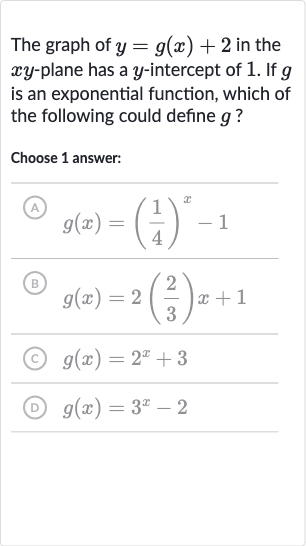Full solution
Q. The graph of in the -plane has a -intercept of . If is an exponential function, which of the following could define ?Choose answer:(A) (B) (C) (D)
- Set and solve: To find the y-intercept of the function , we set and solve for .We are given that the y-intercept is , so:
- Find : Solving for , we get:So, the function must satisfy the condition .
- Check each option: Now we will check each option to see which one satisfies .
(A)
This does not satisfy . - Check each option: Now we will check each option to see which one satisfies .(A) This does not satisfy .(B) This does not satisfy .
- Check each option: Now we will check each option to see which one satisfies .
(A)
This does not satisfy .
(B)
This does not satisfy .
(C)
This does not satisfy . - Check each option: Now we will check each option to see which one satisfies .
(A)
This does not satisfy .
(B)
This does not satisfy .
(C)
This does not satisfy .
(D)
This satisfies .
More problems from Compare linear and exponential growth
QuestionGet tutor help
QuestionGet tutor help
QuestionGet tutor help
QuestionGet tutor help
QuestionGet tutor help
QuestionGet tutor help
QuestionGet tutor help

